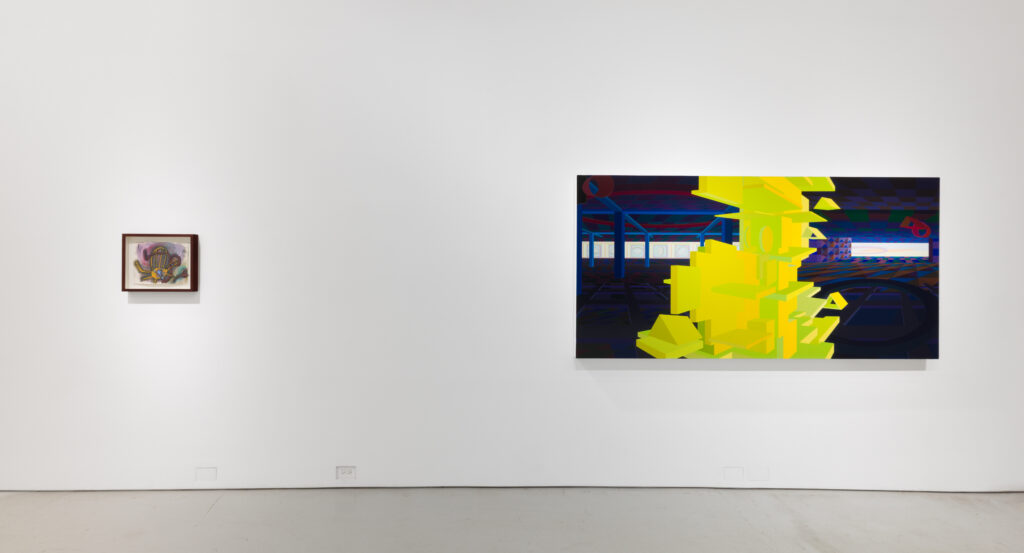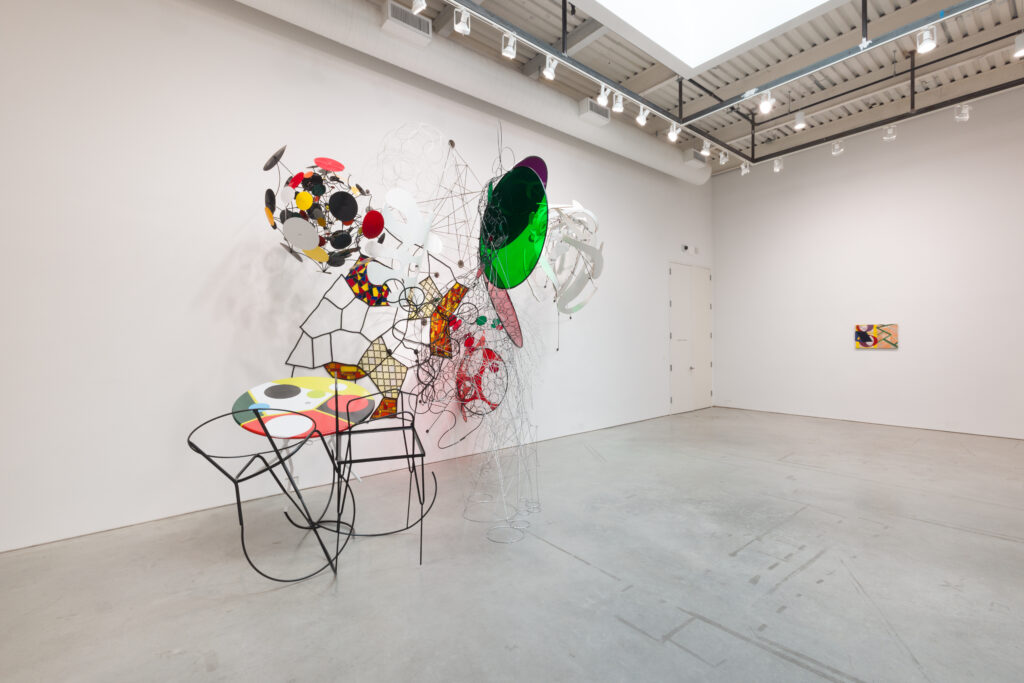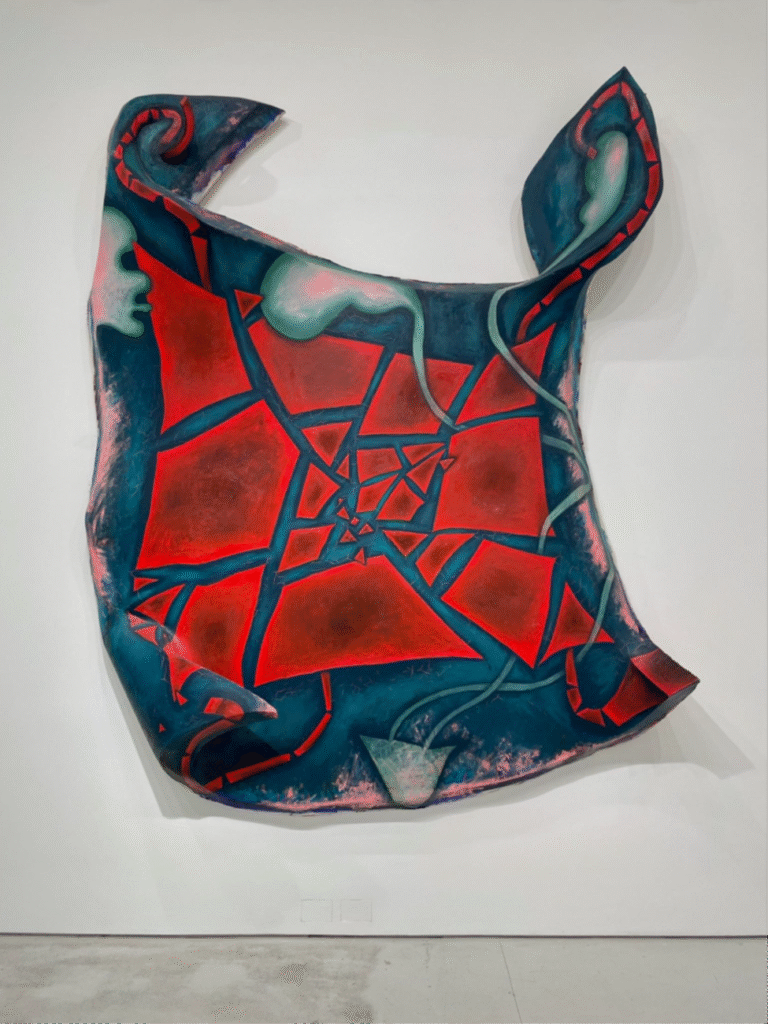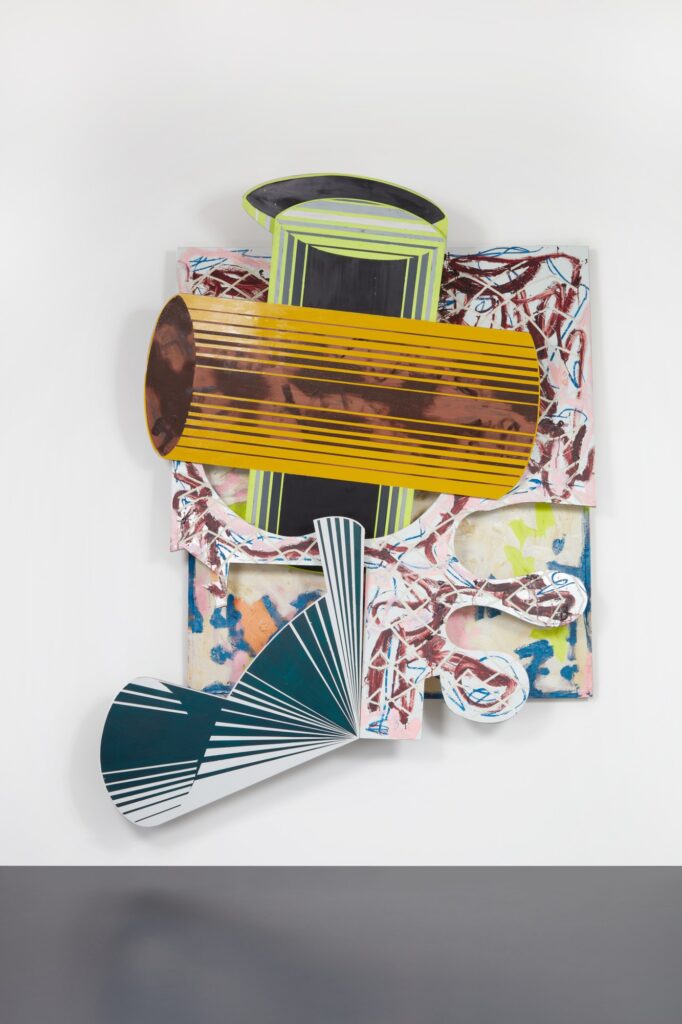
It began, as many enduring ideas do, over wine and conversation. Michael David, painter, curator, and gallerist of M. David & Co., was speaking at a dinner with Judy Pfaff about her close friend and early champion Al Held. The talk drifted to another dear friend, Elizabeth Murray, and then to her admiration for Frank Stella. From that exchange evolved the idea for Singing in Unison, Part 12: Painting in Space, curated by Michael David, and now on view at Art Cake in cooperation with The Brooklyn Rail.
These four artists — Pfaff, Held, Murray, and Stella — each approached geometry as a way of seeing and constructing space. Held treated the pictorial field as a site of real, physical extension — an active void between canvas and viewer. His geometric compositions, informed by Renaissance structure yet charged with a futuristic clarity, turn spatial perception into an architecture of thought.
The late works featured in this show, including Three and Three Quarters (1996) and The Seventh Step (1995), open into a luminous, algorithmic depth — a space both human and computational. Three and Three Quarters evokes a deconstructed De Chirico cityscape, where perspective and illusion oscillate between the metaphysical and the digital, anticipating the logic of machine-generated imagery while remaining grounded in the rigor of paint.

Judy Pfaff, who began as a painter and once reflected that during her Yale MFA she “came in as a painter and left — not a painter,” carried her training into a radical expansion of space. At Yale she studied with Al Held, whose mentorship evolved into a lifelong exchange. From painting she moved into immersive environments — installations that bend, suspend, and weave through their surroundings, interrupting and enveloping at once.
Pfaff’s abstraction has a diaristic flavor, a raw memory of daily life vignettes sprout into an explosive choreography of form and color. Her intensely dynamic wall relief, Es Possible (1989), for instance, emerged as a reaction to watching excessive amounts of soccer during the World Cup in the 1980s — a field of energy translated into spatial rhythm. The work’s multiple sharp light-catching circular forms in primary reds, yellows, black and whites, convey athletic vitality, transforming motion into structure. “The primary focus of that work was figuring out how to structurally position the bent wood and steel. I wanted the piece to project energy outward,” Pfaff says.
Color is central to her language: bold and vivid, it animates geometry with light and emotion. The work brings to mind a dialogue with both Mondrian’s hard-edge jazzy rhythm and Alexander Calder’s mobiles, which balance the pull of gravity and air. In contast to Calder, Pfaff’s welded constructions burst from the wall and gravitate toward the ground, less floating than erupting, more explosive than airy. Her forms seem to grow out of the architecture itself, claiming wall, air, and floor as parts of the same field.

In Barcelona (1991), the other monumental work in this show, Pfaff drew from Gaudí’s architecture of Sagrada Família and Park Güell, translating their gravity defying rhythmic curves and saturated color into suspended vivid structures that shift between drawing and construction. Pfaff visited Barcelona in the late 1960s. At that time, she had been working at a biodynamic farm at a Rudolf Steiner College in England. The relationship between Steiner’s ‘organic architecture’ and Gaudí’s work deeply fascinated and inspired her. “I particularly recall the upside-down model Gaudí used for the cathedral, which employed chains and sandbags to create the parabolic arches. The model is transparent and linear, always a fascination of mine, along with Alexander Calder’s life’s work,” shd says.
Here, Pfaff adds to her array of materials — steel, plastic, and glass — chairs and a table. The intricate web of steel lines become a dynamic spatial drawing, creating a particularly vivid dialogue with Al Held’s rendered space. Altogether, Pfaff’s lines, color and shapes result in a living geometry — an experience of space unfolding through movement, color, and reflection. Pfaff’s work becomes the exhibition’s fulcrum — linking Held’s geometric depth, Murray’s fractured surfaces, and Stella’s constructed planes through an insistence that painting is not only seen but lived.

Elizabeth Murray transformed the flat canvas into shaped, contorted objects. Her fractured forms create what she described as “shattered space”— an elastic field where emotion and geometry intersect. Making It Up (1986) marks a moment when her painting decisively left the rectangle behind. The canvas swells and curves outward, its joined panels forming an animated, almost corporeal structure. The interlocking, rounded forms suggest fragments of the female body — muscular, visceral, and sensual — rendered through luminous color and compressed motion. Its intense physicality merges the architectural with the organic, projecting into real space while retaining the linearity of a drawing. It is a marvel of a painting, exacting in both emotion and invention.

Where Held deepened space within the canvas and Murray fractured it outward, Stella built it. From the disciplined logic of his Black Paintings — shown at MoMA’s Sixteen Americans in 1959, when he was just twenty-three — to the exuberant reliefs of the 1980s, his work traces a shift from formal restraint to engineered complexity.
The work on view, Il Palazzo delle Scimmie 4x (1984), exemplifies that transformation. Executed in acrylic and enamel on aluminum (136 × 106 × 17 inches), it layers painted cones, cylinders, and etched metal elements into a dense orchestration of color and form. The geometry feels at once architectural and animated. Inspired by nineteenth-century stereometric diagrams, Stella used their measured logic to generate precision overtaken by movement. Stella’s constructions stand as built propositions — paintings that assert their own physical authority. Il Palazzo delle Scimmie 4x is both object and image, a structure that redefines painting through the force of its making.

During the 1970s and 1980s, when these artists developed their mature voices, the American art world was shifting from Abstract Expressionism’s intensity to Minimalism’s clarity, and later to the hybrid strategies of post-minimalism and early Postmodernism. Artists questioned not only what art looked like but how it occupied space — whether a painting could be an object, a structure, or an environment.
In that climate, these four artists forged distinct and parallel paths. Stella’s early restraint evolved into volumetric reliefs that blurred painting and architecture. Held pursued a metaphysical geometry that reintroduced depth and perspective. Murray fractured the painted surface into shaped forms pulsing with organic energy. And Pfaff absorbed all these tensions — gesture and structure, depth and flatness — and reconfigured them into environments that dissolved the line between painting and space itself.
Their work traces a continuum of invention across two decades when painting’s definition was in flux. Singing in Unison, Part 12: Painting in Space brings them together for the first time — four distinct yet convergent voices redefining how painting inhabits the world. The exhibition unfolds with the scope of a museum survey, positioning these artists within a lineage that extends from modernism to the present. MoMA—we are waiting.
All photos courtesy of the gallery unless otherwise indicated.
Singing In Unison, Part 12: Painting In Space
Presented by M. David & Co. and Rail Curatorial Projects at Art Cake
Curated by Michael David,
Featuring works by Al Held, Elizabeth Murray, Judy Pfaff and Frank Stella
October 18 – December 7, 2025
About the writer: Etty Yaniv is a Brooklyn-based artist, writer, curator, and founder of Art Spiel. She works in installation, painting, and mixed media, and has shown her art in exhibitions across the United States and abroad. Since 2018 she has published interviews and reviews through Art Spiel, often focusing on underrecognized voices and smaller venues. More about her art can be found at ettyyanivstudio.com and on Instagram @etty.yaniv